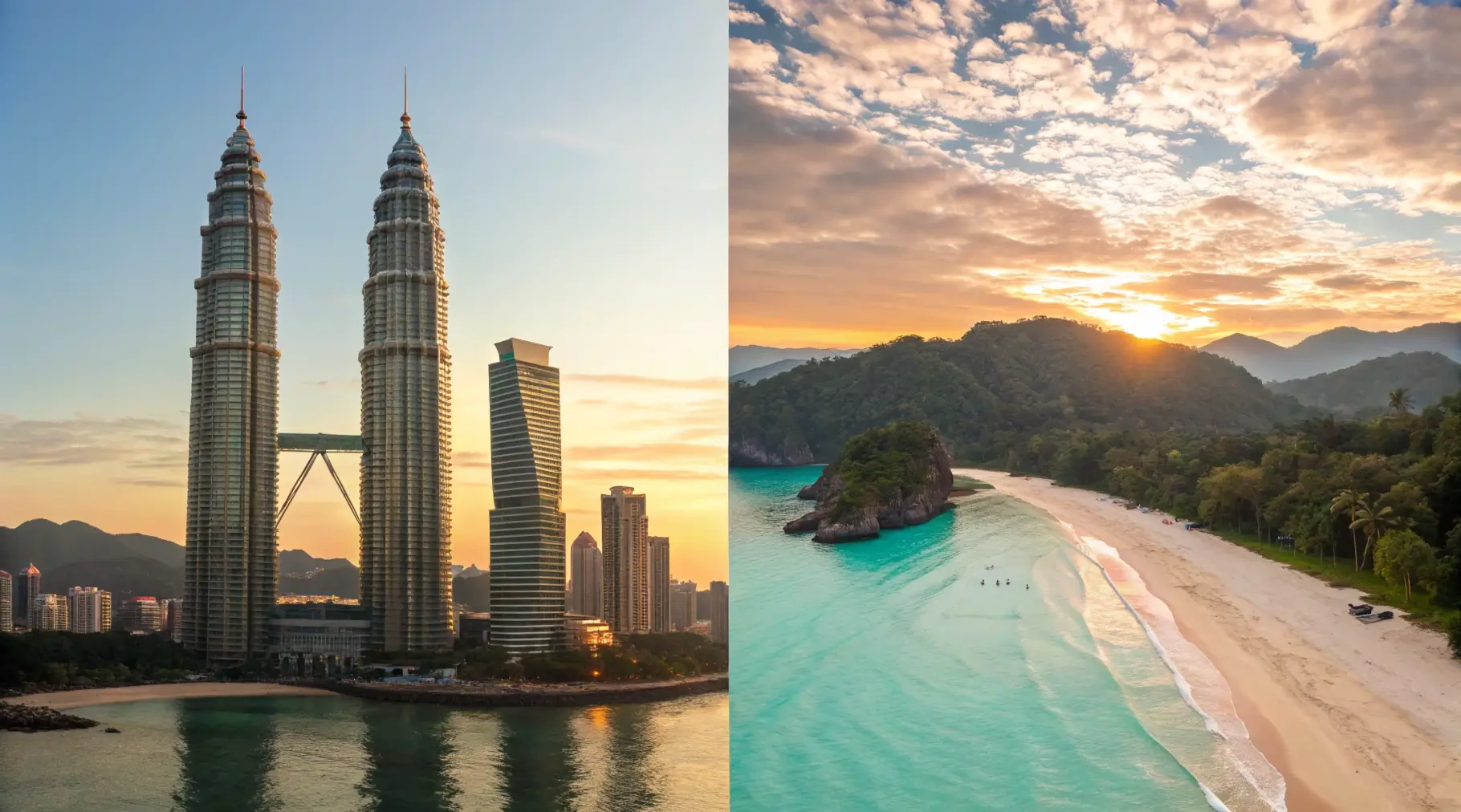Quick Answer: For the best balance across KL & Langkawi, aim for December to February or March to early May. Read on for the detailed breakdown!
Are you dreaming of exploring the vibrant streets of Kuala Lumpur before unwinding on Langkawi’s pristine beaches? This perfect city-island combination offers travelers an authentic taste of Malaysia’s diverse attractions—from ultramodern skyscrapers to untouched natural paradise. But timing your visit right can make all the difference between a dream vacation and a disappointing one.
Malaysia’s climate presents unique considerations for travelers planning to visit both Kuala Lumpur and Langkawi. While these destinations are relatively close geographically, their microclimates can differ significantly, making planning the perfect itinerary a bit challenging. This comprehensive guide will walk you through everything you need to know about the best time to visit Kuala Lumpur and Langkawi, ensuring your Malaysian adventure delivers unforgettable experiences regardless of when you choose to go.
Table of Contents
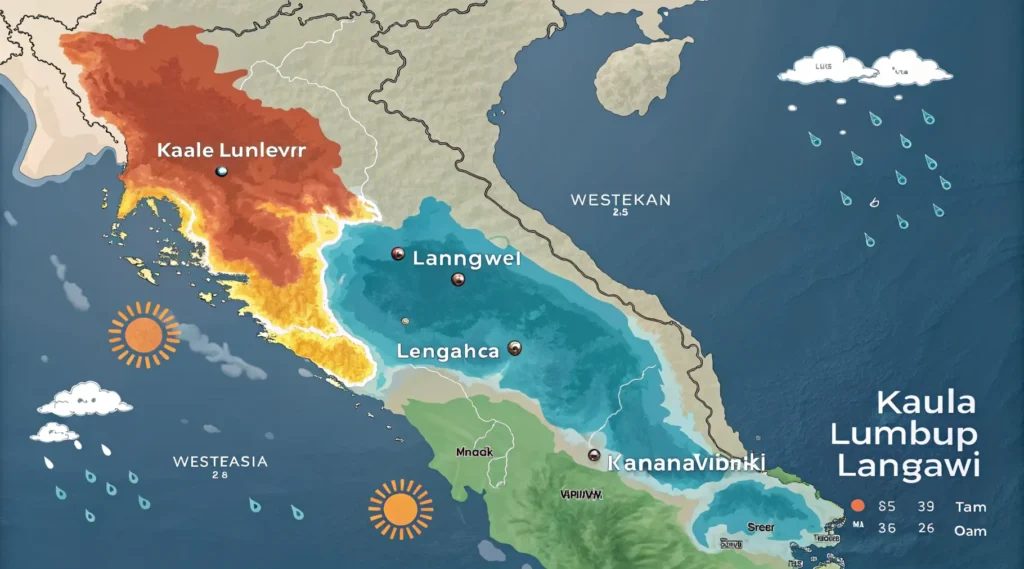
Understanding the Microclimates: Setting the Scene
Both Kuala Lumpur and Langkawi are located on Peninsula Malaysia’s west coast, meaning they generally follow similar weather patterns. The region experiences a tropical climate characterized by high temperatures, humidity, and distinct wet and dry seasons influenced by monsoon winds. According to the Malaysian Meteorological Department, the region’s weather is heavily influenced by the Southwest and Northeast monsoons, with transitional periods bringing unpredictable rainfall.
According to the Malaysian Meteorological Department, while the broader climate patterns affect both destinations similarly, local geography creates notable differences. Kuala Lumpur sits inland, surrounded by mountains, while Langkawi is an archipelago exposed to maritime influences. This distinction means rainfall timing, intensity, and even temperature sensations can differ between the two locations.
What makes planning particularly interesting is that the traditional concept of “seasons” doesn’t apply here as it would in temperate climates. Instead, understanding rainfall patterns, humidity levels, and special local considerations becomes essential for timing your visit perfectly.
Deep Dive: Best Time to Visit Kuala Lumpur
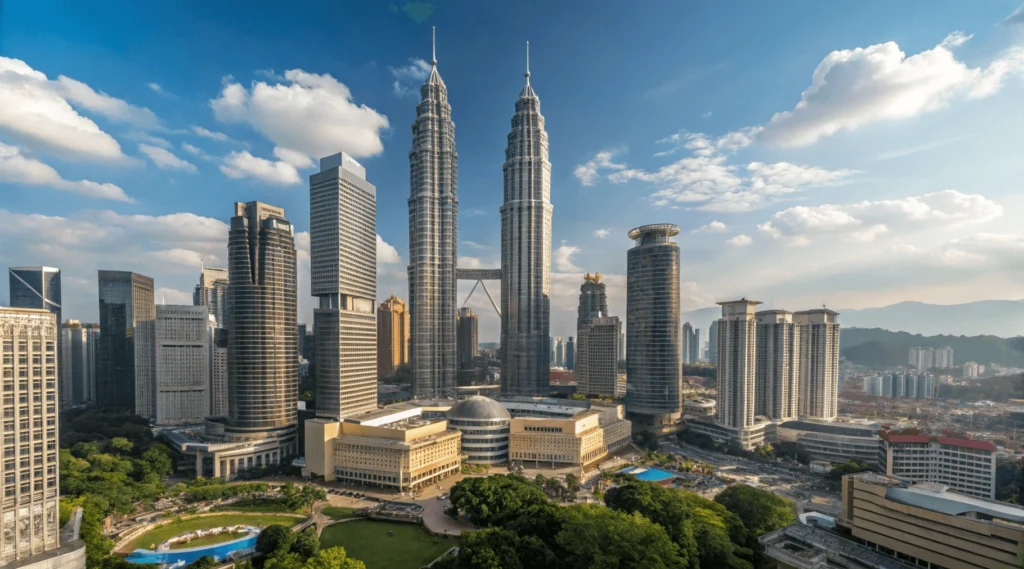
Month-by-Month Breakdown for Kuala Lumpur
| Month | Avg Temp (°C/°F) | Rainfall (mm/inches) | Rainy Days | Humidity | Sunshine (hrs/day) | Rating |
|---|---|---|---|---|---|---|
| January | 28°C/82°F | 150mm/5.9in | 15 | 80% | 6 | ★★★★☆ |
| February | 28°C/82°F | 130mm/5.1in | 13 | 80% | 7 | ★★★★★ |
| March | 29°C/84°F | 210mm/8.3in | 16 | 80% | 7 | ★★★★☆ |
| April | 29°C/84°F | 240mm/9.4in | 18 | 85% | 6 | ★★★☆☆ |
| May | 29°C/84°F | 210mm/8.3in | 17 | 85% | 6 | ★★★☆☆ |
| June | 29°C/84°F | 130mm/5.1in | 12 | 80% | 7 | ★★★★☆ |
| July | 28°C/82°F | 140mm/5.5in | 14 | 80% | 7 | ★★★★☆ |
| August | 28°C/82°F | 150mm/5.9in | 15 | 80% | 6 | ★★★☆☆ |
| September | 28°C/82°F | 190mm/7.5in | 17 | 85% | 6 | ★★★☆☆ |
| October | 28°C/82°F | 270mm/10.6in | 21 | 85% | 5 | ★★☆☆☆ |
| November | 27°C/81°F | 290mm/11.4in | 23 | 85% | 5 | ★★☆☆☆ |
| December | 27°C/81°F | 200mm/7.9in | 19 | 85% | 5 | ★★★☆☆ |
Specific KL Considerations
Haze Season
One of the most significant factors to consider when visiting Kuala Lumpur is the potential for haze. Typically occurring between June and October, this environmental phenomenon results from agricultural burning in Indonesia that can significantly reduce visibility and air quality in KL. The severity varies year to year, with some years experiencing minimal impact while others see unhealthy air quality levels that can affect outdoor activities and photography opportunities. Travelers can monitor real-time air quality updates via Malaysia’s official Air Pollutant Index Management System (APIMS).
Traveler Tip: Check the Malaysian Air Pollutant Index before your trip if visiting during potential haze months. If readings exceed 100, consider bringing N95 masks.
Major Festivals in KL
- Thaipusam (January/February) – This spectacular Hindu festival sees massive processions to Batu Caves, with devotees performing various acts of devotion. Hotels near Batu Caves book up quickly, and traffic can be challenging. Thaipusam is officially recognized and explained in detail by Tourism Malaysia, which highlights its cultural significance and key celebration sites.
- Chinese New Year (January/February) – Expect vibrant decorations throughout the city, especially in areas like Petaling Street, with some businesses closed for several days.
- Hari Raya Aidilfitri (varies, follows Ramadan) – Many KL residents return to their hometowns, creating a unique, quieter city atmosphere. Some smaller shops and restaurants may close, but major attractions remain open.
School Holiday Impact
Malaysia’s school holidays (typically mid-May to early June, late November to December) can significantly impact crowd levels at attractions and shopping malls. International school holidays from neighboring Singapore and other Asian countries can also create tourism peaks.
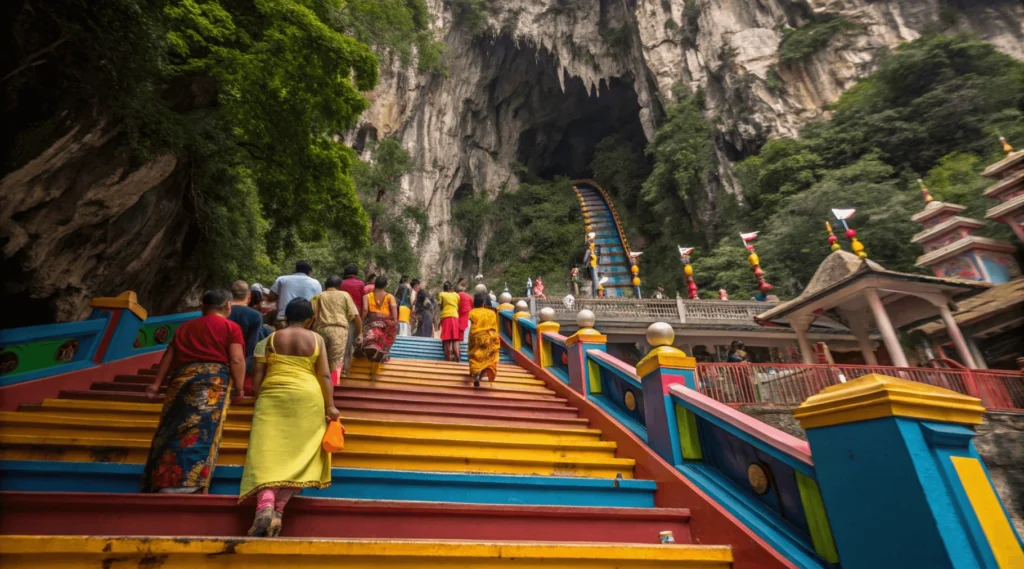
What It’s Really Like in KL During…
December to February: The weather is relatively mild with occasional afternoon showers. The city buzzes with festive energy from Christmas through Chinese New Year. Shopping malls are beautifully decorated, and there’s a celebratory atmosphere despite occasional rain.
March to May: Temperatures climb, and humidity increases, making city exploration more challenging. The reward? Fewer tourists at major attractions like Batu Caves and KLCC Park. Morning or evening activities are best, with afternoons perfect for cooling off in air-conditioned malls or museums.
June to September: You’ll experience a mix of sunny days with brief, intense afternoon showers that typically clear quickly. This is when you might encounter haze, particularly in August and September. The unpredictable air quality makes this period less ideal for skyline photography or outdoor activities.
October to November: The wettest months bring frequent, heavy downpours that can last several hours, occasionally causing flash floods in certain city areas. However, the rain creates spectacular sunset views as storms clear, and you’ll find excellent hotel deals during this off-peak period.
Deep Dive: Best Time to Visit Langkawi
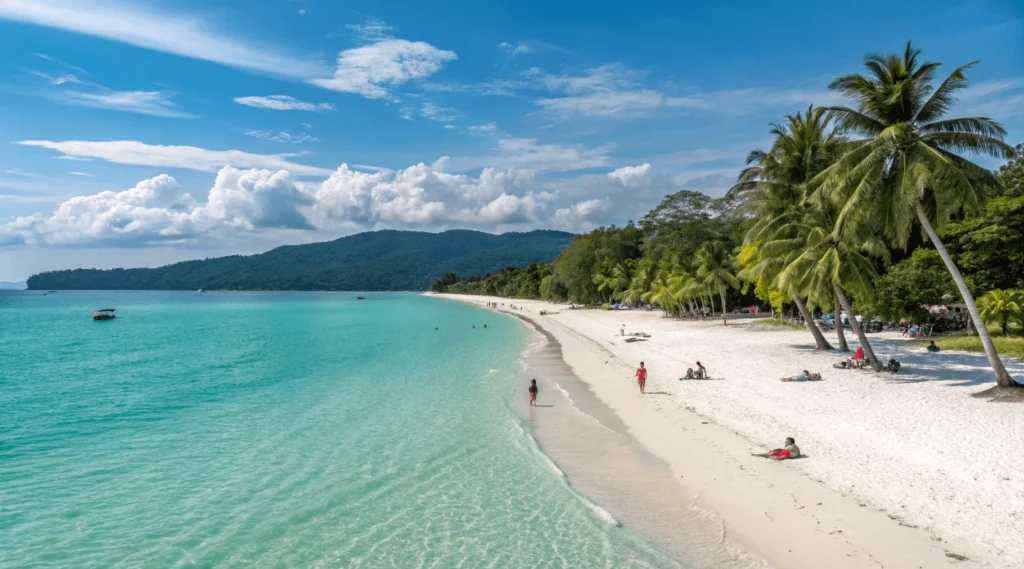
Month-by-Month Breakdown for Langkawi
| Month | Avg Temp (°C/°F) | Sea Temp (°C/°F) | Rainfall (mm/inches) | Rainy Days | Sunshine (hrs/day) | Sea Conditions | Rating |
|---|---|---|---|---|---|---|---|
| January | 29°C/84°F | 28°C/82°F | 40mm/1.6in | 8 | 8 | Excellent | ★★★★★ |
| February | 30°C/86°F | 29°C/84°F | 30mm/1.2in | 7 | 9 | Excellent | ★★★★★ |
| March | 30°C/86°F | 30°C/86°F | 70mm/2.8in | 9 | 8 | Very Good | ★★★★☆ |
| April | 31°C/88°F | 30°C/86°F | 150mm/5.9in | 14 | 7 | Good | ★★★★☆ |
| May | 31°C/88°F | 30°C/86°F | 250mm/9.8in | 18 | 7 | Moderate | ★★★☆☆ |
| June | 30°C/86°F | 29°C/84°F | 200mm/7.9in | 16 | 7 | Moderate | ★★★☆☆ |
| July | 30°C/86°F | 29°C/84°F | 210mm/8.3in | 16 | 7 | Moderate | ★★★☆☆ |
| August | 30°C/86°F | 29°C/84°F | 240mm/9.4in | 19 | 6 | Choppy | ★★★☆☆ |
| September | 29°C/84°F | 29°C/84°F | 340mm/13.4in | 23 | 6 | Rough | ★★☆☆☆ |
| October | 29°C/84°F | 29°C/84°F | 380mm/15in | 24 | 6 | Rough | ★★☆☆☆ |
| November | 29°C/84°F | 29°C/84°F | 230mm/9.1in | 20 | 6 | Improving | ★★★☆☆ |
| December | 29°C/84°F | 28°C/82°F | 70mm/2.8in | 10 | 7 | Good | ★★★★☆ |
Specific Langkawi Considerations
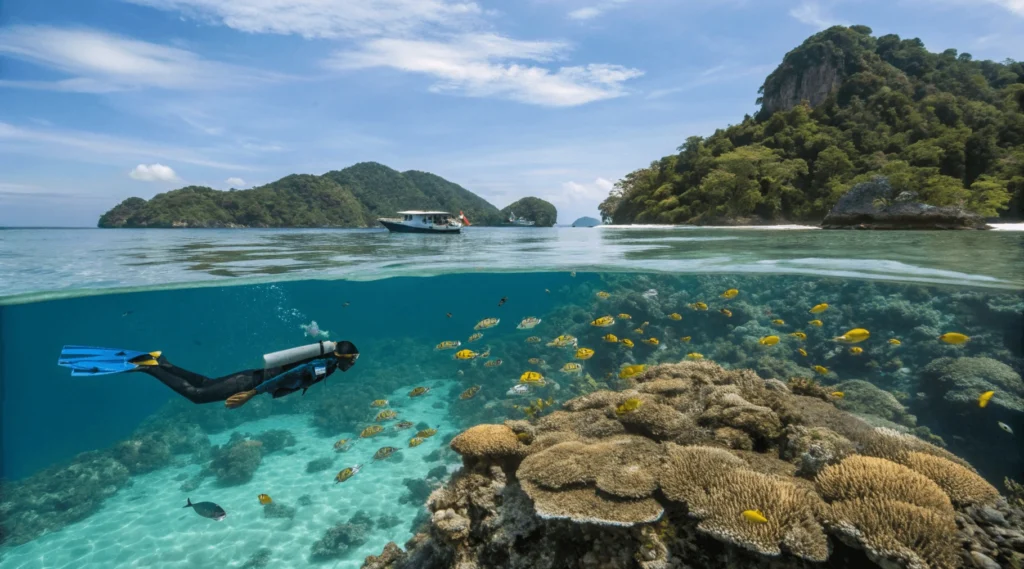
Jellyfish Season
Langkawi experiences jellyfish blooms typically from May to October, with peak presence in June through August. While most species are not dangerous, some areas like Pantai Cenang and Tanjung Rhu beaches may post warnings during these periods. The presence varies by year and specific beach.
Seaweed Season
From June to August, certain beaches (particularly on the southern coast like Pantai Cenang) may experience seaweed accumulation. While this doesn’t make swimming impossible, it can affect the pristine appearance of beaches and create slight odors during decomposition. For updates on beach cleanliness and seasonal changes, you can check Langkawi Development Authority (LADA) bulletins and local travel advisories.
Water Activities Timing
- Snorkeling: Best from December to April when water clarity reaches 15-20 meters
- Diving: December to May offers visibility of 10-15 meters in popular dive sites
- Jet Skiing/Parasailing: Most reliable from December to March when seas are calmest
- Mangrove Tours: Year-round, but especially lush and vibrant after rainy periods (November)
Special Events
The Langkawi International Maritime and Aerospace Exhibition (LIMA) takes place biennially (odd-numbered years), attracting thousands of industry professionals and aviation enthusiasts. During LIMA week, accommodation prices spike significantly, and popular beaches become more crowded with spectators hoping to catch glimpses of air shows.
What It’s Really Like in Langkawi During…
December to February: This peak season delivers picture-perfect beach days with brilliant blue skies, gentle sea breezes, and minimal rainfall. The sea is crystal clear, perfect for snorkeling and underwater photography. Sunsets are spectacular, with vibrant oranges and pinks painting the sky. The drawback? Higher prices and more crowded beaches, particularly at Pantai Cenang and Tanjung Rhu.
March to May: Still excellent beach weather with increasing humidity and occasional afternoon thunderstorms that typically clear quickly. The increasing rainfall brings lush greenery to the island’s interior, making it ideal for nature exploration, cable car rides, and waterfall visits. April begins to see reduced crowds as peak season ends.
June to September: Intermittent rainfall becomes more common, though many days still offer several hours of sunshine. The advantage? Significantly reduced prices and crowd-free beaches. Morning activities are generally safe from rain, while afternoons might require flexible planning. The surrounding forests and mangroves flourish during this period, creating spectacular scenery for photographers.
October to November: The wettest months bring regular downpours, particularly in October. However, between rain showers, you’ll find dramatic skyscapes and rainbows, plus the island at its most lush. November sees conditions gradually improving, sometimes offering surprising stretches of clear weather at bargain prices before the December rush begins.
Langkawi in November: “Expect stunning sunsets after brief showers, and lush greenery that transforms the landscape into a vibrant emerald paradise. While you might need to plan indoor activities during afternoon downpours, the uncrowded beaches and dramatically lower prices make this an underrated time to visit for budget travelers.”
Synthesizing for a Combined KL & Langkawi Trip
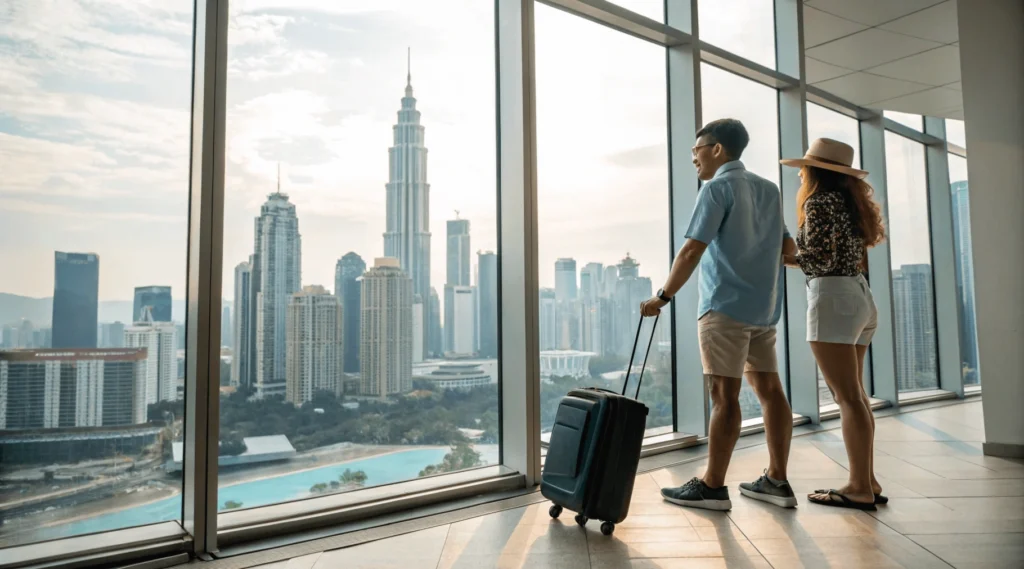
Best Overall Months for KL & Langkawi
When planning a trip that includes both Kuala Lumpur and Langkawi, finding the sweet spot where weather conditions are favorable for both destinations becomes crucial. Based on our analysis of rainfall patterns, temperature, humidity, and special events, here are the optimal periods for experiencing both locations:
December to February (Absolute Best) This period offers the most balanced weather experience across both destinations. While KL experiences moderate rainfall (though less than during the October-November monsoon), Langkawi enjoys its driest and sunniest period. The slightly cooler temperatures in KL (around 27-28°C/81-82°F) make city exploration more comfortable, while Langkawi’s perfect beach conditions (minimal rain, calm seas) create ideal island relaxation.
March to Early May (Excellent Alternative) This shoulder season still provides favorable conditions for both destinations. KL sees increasing heat but manageable rainfall, while Langkawi maintains mostly sunny days with occasional brief showers. Water visibility remains excellent for snorkeling and diving in Langkawi, and KL’s attractions are less crowded than during peak holiday periods.
Shoulder Season Strategy for KL & Langkawi
If peak season prices or crowds are concerns, consider these strategic alternatives:
Late June to Early August While not perfect weather-wise, this period offers a reasonable compromise. In KL, you’ll experience moderate rainfall (often as afternoon showers) with potential haze concerns, but many days remain workable for sightseeing if you plan morning activities. Langkawi will have more rainfall than during peak season, but the island rarely experiences all-day downpours during this period. The significant advantage? Much lower accommodation prices and fewer tourists at popular spots.
Late November This transitional period sees Langkawi emerging from its wettest month (October) while KL is still experiencing considerable rainfall. However, hotel prices haven’t yet reached peak season levels, and you might enjoy surprising stretches of good weather in Langkawi as the dry season begins. This timing works especially well if you plan more indoor activities in KL (shopping, museums, culinary experiences) while enjoying Langkawi’s increasingly favorable beach conditions.
Planning Around Monsoons for Both
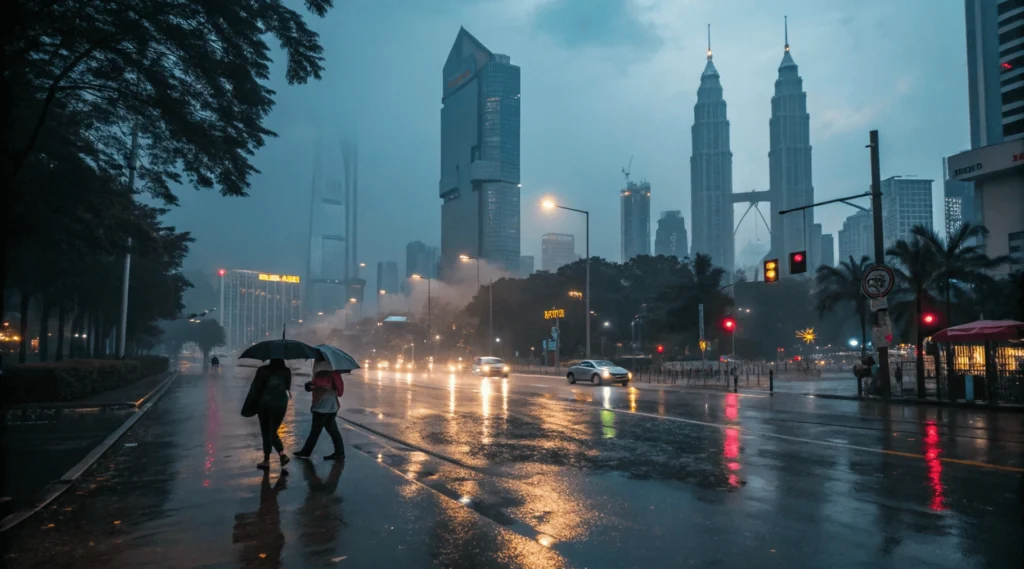
If your travel dates fall during wetter periods, here’s how to navigate:
For KL During Peak Rains (October-November):
- Schedule indoor activities during afternoons when rain is most likely
- Book accommodations near MRT/LRT stations to minimize walking in downpours
- Include major shopping malls in your itinerary as rain shelters
- Take advantage of lower hotel rates and fewer tourists at attractions
For Langkawi During Peak Rains (September-October):
- Choose accommodations with covered amenities and indoor facilities
- Consider higher-end resorts that offer shuttle services and indoor alternatives
- Focus on spa treatments, culinary experiences, and shorter outdoor excursions during morning hours
- Book flexible tour options that offer rain checks or alternative activities
Itinerary Flow Recommendations
Based on weather patterns, here’s how to structure your combined KL-Langkawi trip:
During December-February (Optimal Season): Start with 3-4 days in KL for cultural and urban exploration, then fly to Langkawi for 4-5 days of perfect beach weather. This sequence makes sense year-round but is especially perfect during these months.
During Wetter Months (September-November): Consider reversing the order—begin with Langkawi while accepting some rainfall in exchange for lower prices and fewer crowds, then end your trip in KL where indoor attractions provide reliable entertainment regardless of weather.
Beyond Weather: Other Factors Influencing the “Best Time”
Crowd Levels: Peak vs. Off-Peak vs. Shoulder
Peak Season (December-February)
- KL: Major attractions like Batu Caves and Petronas Towers may require 30+ minute waits
- Langkawi: Popular beaches (especially Pantai Cenang) become crowded; restaurants often require reservations
- Both: Photography spots often have queues; tour availability becomes limited without advance booking
Shoulder Season (March-May, June-August)
- KL: Moderate crowds at major attractions with minimal waits during weekdays
- Langkawi: Beaches have comfortable space, even at popular spots like Pantai Cenang
- Both: More relaxed atmosphere; photography without crowds becomes easier
Off-Peak (September-November)
- KL: Major attractions have minimal waits even on weekends
- Langkawi: Beaches often feel private, especially on weekdays
- Both: Tour operators more willing to customize experiences; no need for advance restaurant reservations
Price Fluctuations
Flight Pricing Trends:
- Peak pricing: Mid-December to early January (holiday season), Chinese New Year
- Secondary peaks: July-August (European summer holidays)
- Best deals: September-October, early November, For up-to-date price comparisons and travel demand forecasts, refer to Malaysia Airports Holdings Berhad (MAHB) and airline sales calendars from Malaysia Airlines or AirAsia.
- Average price difference: 30-50% between peak and off-peak for international flights to KL
Accommodation Pricing:
- KL: 5-star hotels average RM450-600 during off-peak, rising to RM700-900 during peak periods
- Langkawi: Beachfront resorts average RM350-500 during off-peak, jumping to RM800-1200 during peak season
- Overall savings potential: 40-60% by traveling during shoulder or off-peak seasons
Festivals & Events Impact
Festival Price Premiums:
- Chinese New Year (January/February): 20-40% accommodation increase in KL’s Chinese districts
- School holidays (mid-May to early June, late November to December): 15-30% increase overall
- LIMA Exhibition (biennial): 50-100% increase in Langkawi accommodation during the event week
Event Benefits:
- Cultural festivals offer unique experiences that may outweigh weather considerations
- Thaipusam at Batu Caves (January/February) provides once-in-a-lifetime photographic and cultural opportunities
- Hari Raya celebrations transform KL with stunning light displays and special cultural events
School Holiday Considerations
Malaysian School Holidays:
- Mid-March (1 week)
- Late May to mid-June (3 weeks)
- Late August to early September (1 week)
- Mid-November to December (6-7 weeks)
International Impact:
- Singapore school holidays (similar to Malaysian schedule) significantly impact Langkawi visitor numbers, You can verify school term dates for Malaysia and Singapore at their respective education ministry portals: MOE Malaysia and MOE Singapore.
- Chinese New Year (January/February) creates major tourism influx from mainland China, Hong Kong, and Taiwan
- European summer holidays (June-August) create a secondary high season for Langkawi’s luxury resorts
“Best Time” Tailored to Traveler Types
For Beach Lovers (Langkawi focus, KL as add-on)
Optimal Timing: January to early March Why: Peak beach conditions in Langkawi with maximum sunshine, minimal rainfall, and excellent water clarity for snorkeling and diving. KL serves as a convenient 2-3 day cultural add-on. Pro Tip: Stay in Tanjung Rhu for quieter beaches even during peak season.
For City Explorers & Shoppers (KL focus, Langkawi as escape)
Optimal Timing: June to early August (avoiding potential haze periods) Why: Moderate KL weather with shopping sales during this period, followed by refreshing island time when city exploration becomes tiring. Pro Tip: Mid-year sales in KL offer excellent shopping opportunities, while Langkawi’s duty-free status provides additional savings.
For Families
Optimal Timing: December holidays or March-April Why: Balances good weather with school holiday timing; December offers festive atmosphere while March-April provides slightly lower crowds while maintaining good weather. Pro Tip: Book accommodations with indoor alternatives (pools, kids’ clubs) to handle unexpected rain showers.
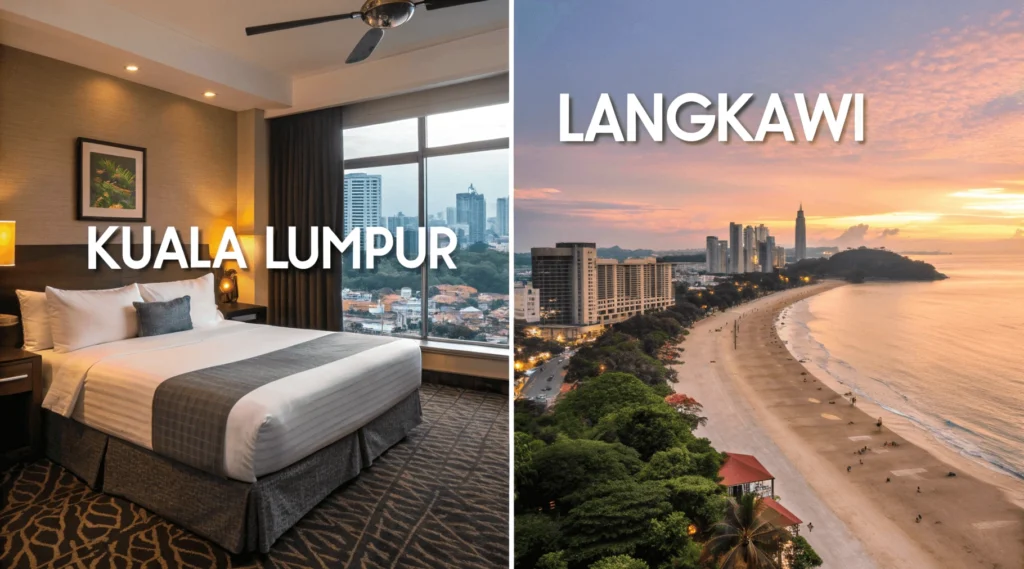
For Budget Travelers
Optimal Timing: Late April-May or November Why: These shoulder months offer the best balance of acceptable weather and significantly reduced prices (30-50% savings). Pro Tip: November in particular can offer surprising weather windows in Langkawi as the island transitions to dry season, while still maintaining low-season pricing.
For Honeymooners/Couples
Optimal Timing: February-March Why: Post-holiday season means reduced crowds while maintaining excellent weather conditions in both destinations. Pro Tip: Split your stay with 2 nights in KL followed by 5 nights in Langkawi for the perfect balance of urban exploration and romantic beach time.
For Photographers
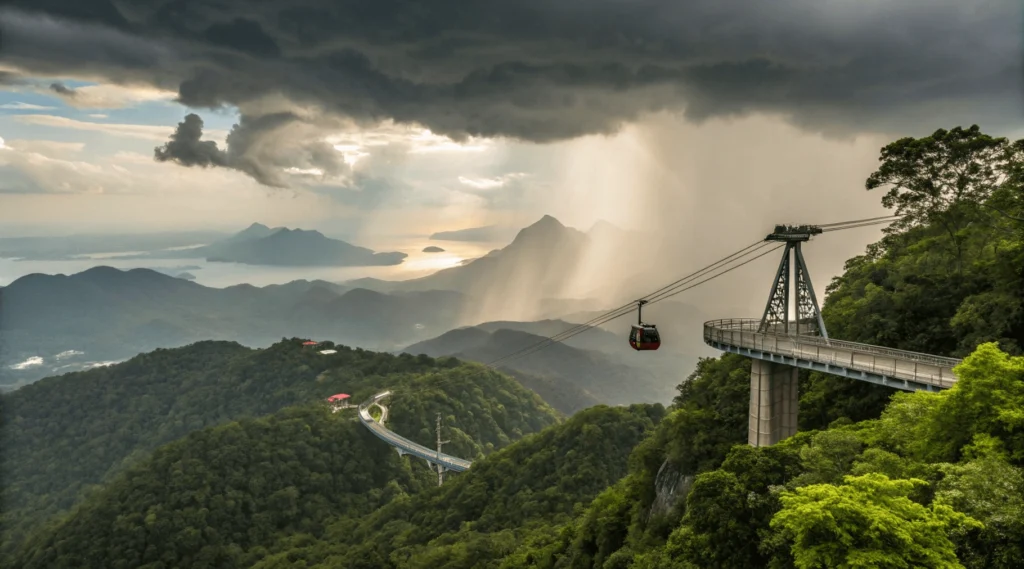
Optimal Timing: Late November to December for Langkawi; February-March for KL Why: Langkawi’s landscape appears most vibrant after the rainy season with dramatic skies and lush scenery. KL experiences clearer air quality during February-March before potential haze season. Pro Tip: The cable car and Sky Bridge in Langkawi offer spectacular photography after rainfall periods when visibility extends to Thailand on clear days.
Practical Tips for Planning Your Visit
Booking Windows for Best Deals
- Flights: Book 3-4 months in advance for December-February trips; 6-8 weeks is sufficient for shoulder season
- KL Hotels: 4-6 weeks advance booking provides optimal rates; last-minute deals often available during off-peak
- Langkawi Resorts: Premium beachfront properties require 3-4 months advance booking during peak season; 2-3 weeks sufficient during off-peak
Seasonal Packing Guide
December-February:
- Light breathable clothing
- Compact umbrella for occasional KL showers
- Sun protection (hat, sunglasses, high SPF sunscreen)
- Light jacket for evening sea breezes in Langkawi or air-conditioned spaces
March-May:
- Lightest possible clothing for increasing heat
- Portable fan and cooling towel for KL exploration
- Reusable water bottle to stay hydrated
- Water-resistant bag for electronic items during surprise showers

June-October:
- Quick-dry clothing that handles humidity
- Waterproof phone case and bag
- Multiple footwear options for varying conditions
- N95 masks for potential haze periods in KL (particularly August-September)
November:
- Similar to December-February list but with greater emphasis on rain protection
- Water-resistant outerwear for KL
- Extra set of dry clothes when traveling between locations
Visa Information
Malaysia offers visa-free entry for citizens of many countries for stays of 30-90 days, including most Western nations, Singapore, and many ASEAN countries. Always check the latest requirements with official Malaysian immigration sources or your local Malaysian embassy before travel, as regulations can change.
Conclusion: Finding Your Perfect Time
The best time to visit Kuala Lumpur and Langkawi together largely depends on your priorities—whether you’re seeking perfect beach weather, cultural immersion, budget savings, or photography opportunities.
For the majority of travelers seeking the optimal balance, December to February provides the most reliable weather conditions across both destinations. This period offers comfortable temperatures for exploring KL’s urban attractions while guaranteeing optimal beach and water conditions in Langkawi.
However, savvy travelers willing to accept occasional weather compromises can find exceptional value during shoulder seasons—particularly March to early May and late November, when conditions remain largely favorable while crowds thin and prices drop significantly.
Remember that Malaysia’s tropical climate means brief rain showers can occur year-round, so flexibility in your daily itinerary planning is always advisable. With proper preparation and realistic expectations, a combined KL-Langkawi trip can deliver extraordinary experiences in any month.

Frequently Asked Questions
Q: What is the absolute best single month for both KL and Langkawi?
February typically offers the optimal balance—comfortable temperatures and moderate rainfall in KL paired with Langkawi’s peak dry season conditions. The post-Chinese New Year period (mid-to-late February) is especially ideal as crowds begin to thin while weather remains excellent.
Q: Is it okay to visit KL and Langkawi during the rainy season?
Yes, but with preparation. October in particular sees heavy rainfall in both destinations. However, rain typically follows patterns (often afternoon showers in KL) rather than all-day downpours. Accommodation prices drop significantly, and between showers, you’ll experience lush landscapes and fewer tourists. Indoor activities in KL and periodic beach sessions in Langkawi remain entirely viable.
Q: How bad is the haze in KL/Langkawi?
The severity varies dramatically year to year. Some years see minimal impact, while others experience unhealthy air quality levels lasting weeks. KL typically experiences more significant haze than Langkawi due to its inland location. If visiting during potential haze season (June-October, worst in August-September), monitor the Malaysian Air Pollutant Index before your trip and consider bringing N95 masks just in case.
Q: How much should I budget for a 7-day KL and Langkawi trip?
During peak season (December-February), budget approximately RM8,000-12,000 (USD1,900-2,850) for mid-range accommodations, dining, and activities for two people, excluding international flights. During off-peak periods (September-November), the same itinerary might cost RM5,000-8,000 (USD1,200-1,900).
Q: Is Langkawi worth visiting during September or October?
For budget travelers, yes. While rainfall increases significantly, the island rarely experiences continuous all-day downpours. Morning activities often remain viable, and you’ll benefit from 40-60% discounts on accommodation plus significantly reduced crowds. Beach time becomes less reliable, but island tours, spa experiences, and cultural activities remain enjoyable.
Have questions about planning your KL & Langkawi trip? Ask in the comments below! Or check out our detailed [5-Day Kuala Lumpur Itinerary] or [Langkawi Hidden Beaches Guide] for more inspiration!
Last updated: May 2025

